UPS APC BC750-RS - convenient protection for the "home office"
The principle of operation of an uninterruptible power supply (UPS) of the offline type was proposed several decades ago. If the supply voltage is outside the limits set by the user, the power is automatically switched to the inverter, which receives power from the battery. Offline UPSs still have such undeniable advantages as compactness, ease of use and low cost. Therefore, technical progress did not lead to their disappearance. Moreover, the interest in offline UPS has recently grown. More and more people are working remotely from home, for which Offline UPSs are still the most convenient. Even if you use only a laptop or a tablet for work from home, the UPS will provide Wi-Fi router and a phone with a DECT radio extension (English Digital Enhanced Cordless Telecommunication - advanced digital wireless communication) when there is a power outage telecom operators are able to provide services in such conditions). And for short-term failures - to avoid restarting the Wi-Fi router and the DECT base station, which takes a lot of time.

This time we will talk about the UPS APC BC750-RS. Before us is the “classic of the genre” - Offline UPS, to which you can connect the typical desktop computer system unit, as well as some peripheral devices. Total power output can reach 750 VA, the active power - 415 watts. As of 2017, this output power is enough for professional video editing with a resolution up to Full HD inclusive and amateur editing with a resolution up to 4K inclusive. One of the few applications for which the power of the APC BC750-RS is not enough is the power of the computer on which professional video editing is carried out with a 4K resolution. Also, the considered UPS will not be enough in power for advanced gamers - they use computers, the peak power consumption of which exceeds its capabilities. But all other users will undoubtedly appreciate the relatively small size of the UPS, the ease of managing it, and the low cost. The average price of APC BC750-RS, according to Yandex.Market, in September 2017 was 5,220 rubles.
Technical characteristics of APC Back-UPS BC750-RS

The APC BC750-RS box contains only the UPS itself, as well as a quick installation guide. Software and user manuals are downloaded from the Internet, which is quite logical, since they can be changed. No, and USB-cable - all the same, users usually buy their own cable of the desired length. The power cable with the socket is one with the UPS, which is convenient for home use. Also, an advantage when using the device at home is to equip the UPS at the outlet with Schuko-type sockets, commonly referred to as “German-standard sockets”. This allows you to connect without special cables and conductors computers, as well as peripheral devices to them, designed for use in everyday life.
')
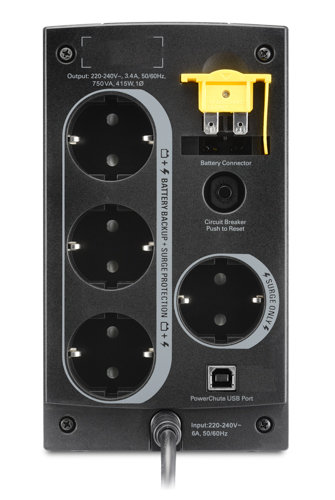
Four power sockets are installed on the output. Three of them are protected by a filter that suppresses sudden voltage spikes, as well as battery backup power. The manual contains a long list of devices that can not be connected to these outlets. Common to all devices from this list is that they use electric motors that are powered from the AC mains directly, without an additional power supply. There is no direct ban on the connection of a video projector. However, we strongly recommend that you consult with your video projector provider for the possibility of using it with this UPS model. The fourth socket is protected only by a filter, it can include a wide variety of types of load, but if the input voltage is lost, no power will be supplied to it.
The UPS outputs are protected against overload. In the event that the total load on the outputs exceeds 415 W of active power (note that you need to sum up the active power, and the attached software also determines only the active component), the UPS will give an alarm and, if the overload is not eliminated, some time off. When a very strong overload, for example, in the event of a short circuit at the output, the built-in fuse instantly operates. To restore work after such an event, just press the button on the back of the UPS.
Also in the APC BC750-RS there is switchable protection of outputs with backup power against too low power consumption. When the power consumed by the load is less than 15 W, the UPS shuts down after 15 minutes. Why do you need it? After shutting down computers and some other types of equipment, if you do not physically pull the cable out of the socket, continue to consume a small amount of electricity. Thus, the battery continues to discharge even after the computer has safely shut down. Turning off the UPS eliminates the unnecessary discharge of the battery. But when powering a Wi-Fi router or DECT base station, this function should be disabled.
The main task that the APC BC750-RS solves in case of a long-term power failure is to provide the computer with power for as long as it goes into hibernation mode (copying the contents of RAM to the hard disk and then disconnecting most of the computer’s nodes). Upon detecting that the input voltage is out of the specified limits, the UPS switches the power to the battery, sending a signal through the USB port to the computer where the PowerChute software is installed. Next, the user selects one of two possible scenarios. Either the hibernation begins after a predetermined time after a power failure. Either the program estimates the time remaining until the battery is completely discharged, and starts hibernation within the user-specified period of time before this event.
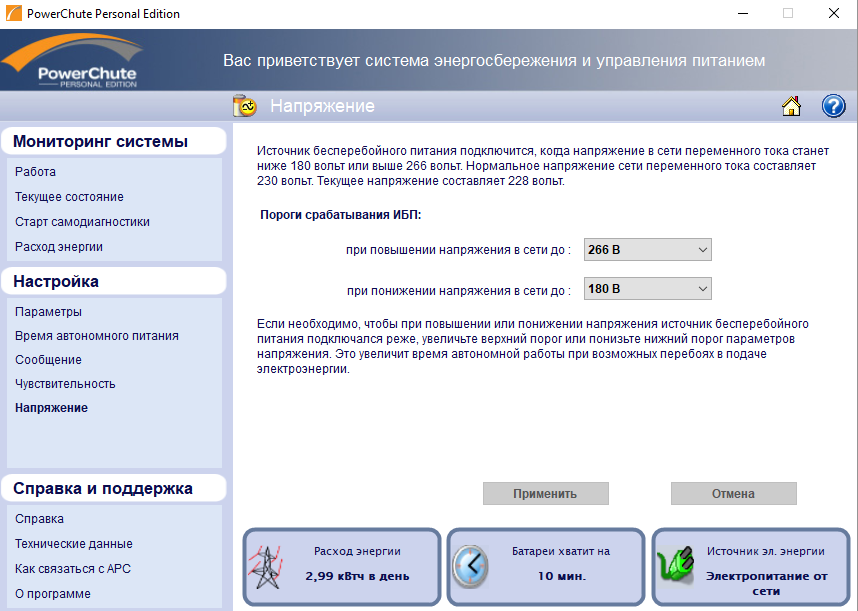
PowerChute also allows you to adjust the upper and lower thresholds of the input voltage in 1 V increments, at which switching to the backup battery occurs. The optimal values of these thresholds should be such that, on the one hand, fluctuations in the computer supply voltage do not lead to data loss, and, on the other hand, the UPS does not operate too often. The function of measuring the voltage at the input, implemented in the program, is designed to help in setting the limits, but in practice it is enough to choose one of the three ready-made presets. And the default is set to a range that meets the conditions of an average city apartment. Through the PowerChute menu, you can also configure automatic shutdown of the sound alarm at a certain time interval (for example, at night). In addition, PowerChute keeps statistics on power consumption, a power failure log, and also performs self-diagnostics of the UPS.
You can select one of the three preset input voltage ranges, as well as turn on / off the protection function against output power consumption without PowerChute, using the UPS programming mode. It is described in the brief installation instructions, we will not repeat the description here. We only note that in the current version of PowerChute Personal Edition 3.0.2, it is not possible to control the protection against power consumption at the output; this can be done only through the programming mode.
The APC Back-UPS 750 VA manual states that the battery is not self-replaceable. In fact, the design of the UPS allows you to change the battery if necessary, but the APC policy can be explained by concern for the safety of consumers. Since access to the battery cannot be obtained without partially disassembling the device, there is a bright yellow jumper with which you can turn off the battery during the transportation of the device. Before first use, it is installed during working hours. Also, before first use, you need to connect the UPS to the mains for 10 hours to charge its battery. It is possible to install a new battery at an authorized APC service center.
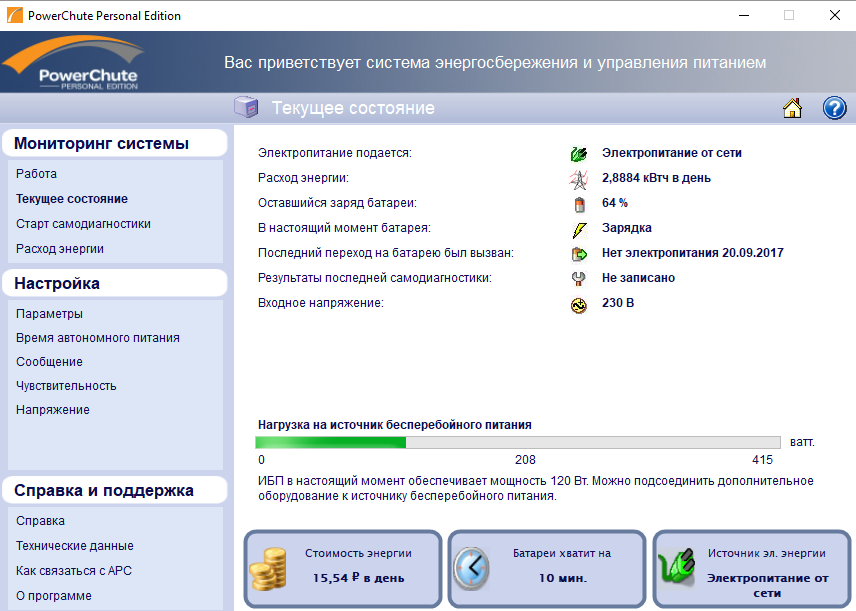
After carrying out the necessary preparatory work, we started testing. As a load, a system unit was used on an Intel Core i5-4670 K processor with a clock frequency of 3400 MHz, an Nvidia GTX 770 video card and RAM running at 1600 MHz. It can work with office applications, graphic editors and perform simple video processing. When testing on a computer, photographs were edited, with an average power consumption of 116 watts.
To adjust the input voltage was used LATR. The operation of the UPS was checked at the lower limits of the input voltage 160; 180 and 196 V. Testing has shown the exact compliance of the real voltage of operation with the set values. But the return to normal operation occurs at a voltage that is 12 V above the threshold.
After switching to battery operation, the output voltage was 219 V, which is 4.8% lower than the stated nominal value of 230 V, however, it fits into the limits allowed by the manufacturer ± 8% of the nominal value, and, moreover, meets the requirements of current GOST.

Making sure that if the power to the computer is suddenly cut off, the important files will not be lost, we disconnected the USB cable, making hibernation impossible due to the command received from the UPS. After that, the UPS was disconnected from the network (the tricks are performed by professionals, do not try to repeat them!) The operating time of the system unit from the battery was 14 minutes. From this it follows that with a load of about 116 W, you can select the option “Keep the computer turned on as long as possible” and specify any time from the proposed range from 5 to 8 minutes, in any case, there is a large margin in time. But, if the power of the load is close to the maximum permissible, then it is better to select the option “Save battery energy” and a short duration of work from backup power.
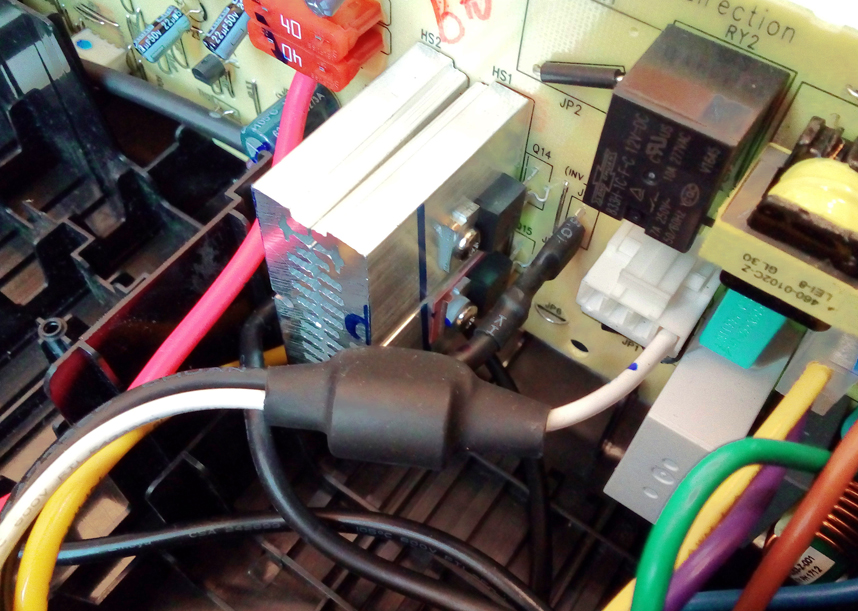
And finally, what we saw inside the APC BC750-RS. Most electronic components are located on fiberglass PCB. The use of this material provides high reliability. The inverter uses MOSFET transistors from International Rectifier, a leading global manufacturer of UPS components. It also uses an impressive size transformer from the famous Taiwanese manufacturer CSE Power.
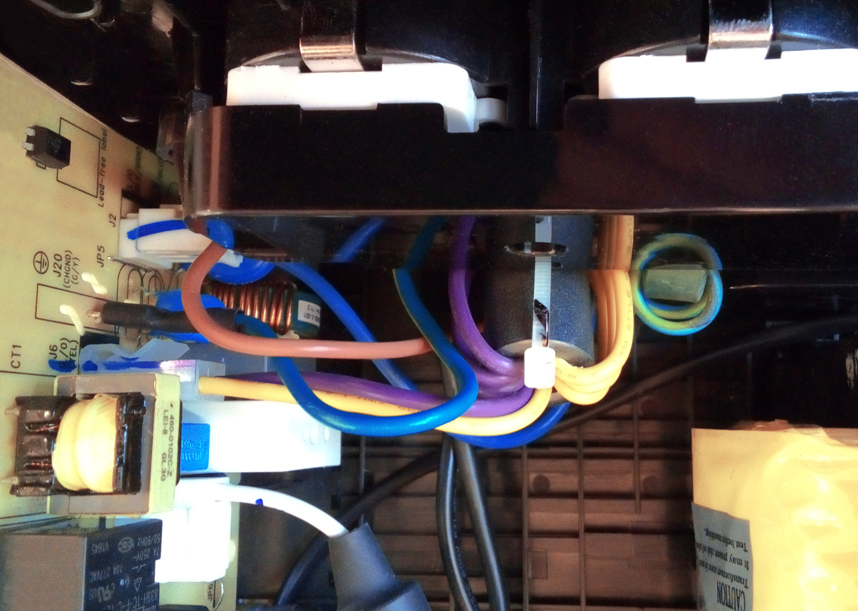
Ferrite filters are installed at the input and output, providing effective suppression of high-frequency interference. At the outputs, which, if necessary, automatically switch to backup power, interference is caused not only by switching, but by the non-sinusoidal output voltage. To suppress them, a ferrite filter of a cylindrical special alloy construction is used. In general, the design is all thought out, as befits such a solid company.
The APC BC750-RS is an affordable, convenient UPS that is optimal for home use. But, in contrast to the now widely spread household ultra-compact UPS, externally similar to extension cords, the APC BC750-RS is designed specifically for those who work from home in remote mode. Extensive tuning capabilities, as well as the quality of performance at the level of professional equipment, allow you to reliably protect the results of work in the event of a power failure.

This time we will talk about the UPS APC BC750-RS. Before us is the “classic of the genre” - Offline UPS, to which you can connect the typical desktop computer system unit, as well as some peripheral devices. Total power output can reach 750 VA, the active power - 415 watts. As of 2017, this output power is enough for professional video editing with a resolution up to Full HD inclusive and amateur editing with a resolution up to 4K inclusive. One of the few applications for which the power of the APC BC750-RS is not enough is the power of the computer on which professional video editing is carried out with a 4K resolution. Also, the considered UPS will not be enough in power for advanced gamers - they use computers, the peak power consumption of which exceeds its capabilities. But all other users will undoubtedly appreciate the relatively small size of the UPS, the ease of managing it, and the low cost. The average price of APC BC750-RS, according to Yandex.Market, in September 2017 was 5,220 rubles.
Technical characteristics of APC Back-UPS BC750-RS

The APC BC750-RS box contains only the UPS itself, as well as a quick installation guide. Software and user manuals are downloaded from the Internet, which is quite logical, since they can be changed. No, and USB-cable - all the same, users usually buy their own cable of the desired length. The power cable with the socket is one with the UPS, which is convenient for home use. Also, an advantage when using the device at home is to equip the UPS at the outlet with Schuko-type sockets, commonly referred to as “German-standard sockets”. This allows you to connect without special cables and conductors computers, as well as peripheral devices to them, designed for use in everyday life.
')

Four power sockets are installed on the output. Three of them are protected by a filter that suppresses sudden voltage spikes, as well as battery backup power. The manual contains a long list of devices that can not be connected to these outlets. Common to all devices from this list is that they use electric motors that are powered from the AC mains directly, without an additional power supply. There is no direct ban on the connection of a video projector. However, we strongly recommend that you consult with your video projector provider for the possibility of using it with this UPS model. The fourth socket is protected only by a filter, it can include a wide variety of types of load, but if the input voltage is lost, no power will be supplied to it.
The UPS outputs are protected against overload. In the event that the total load on the outputs exceeds 415 W of active power (note that you need to sum up the active power, and the attached software also determines only the active component), the UPS will give an alarm and, if the overload is not eliminated, some time off. When a very strong overload, for example, in the event of a short circuit at the output, the built-in fuse instantly operates. To restore work after such an event, just press the button on the back of the UPS.
Also in the APC BC750-RS there is switchable protection of outputs with backup power against too low power consumption. When the power consumed by the load is less than 15 W, the UPS shuts down after 15 minutes. Why do you need it? After shutting down computers and some other types of equipment, if you do not physically pull the cable out of the socket, continue to consume a small amount of electricity. Thus, the battery continues to discharge even after the computer has safely shut down. Turning off the UPS eliminates the unnecessary discharge of the battery. But when powering a Wi-Fi router or DECT base station, this function should be disabled.
The main task that the APC BC750-RS solves in case of a long-term power failure is to provide the computer with power for as long as it goes into hibernation mode (copying the contents of RAM to the hard disk and then disconnecting most of the computer’s nodes). Upon detecting that the input voltage is out of the specified limits, the UPS switches the power to the battery, sending a signal through the USB port to the computer where the PowerChute software is installed. Next, the user selects one of two possible scenarios. Either the hibernation begins after a predetermined time after a power failure. Either the program estimates the time remaining until the battery is completely discharged, and starts hibernation within the user-specified period of time before this event.

PowerChute also allows you to adjust the upper and lower thresholds of the input voltage in 1 V increments, at which switching to the backup battery occurs. The optimal values of these thresholds should be such that, on the one hand, fluctuations in the computer supply voltage do not lead to data loss, and, on the other hand, the UPS does not operate too often. The function of measuring the voltage at the input, implemented in the program, is designed to help in setting the limits, but in practice it is enough to choose one of the three ready-made presets. And the default is set to a range that meets the conditions of an average city apartment. Through the PowerChute menu, you can also configure automatic shutdown of the sound alarm at a certain time interval (for example, at night). In addition, PowerChute keeps statistics on power consumption, a power failure log, and also performs self-diagnostics of the UPS.
You can select one of the three preset input voltage ranges, as well as turn on / off the protection function against output power consumption without PowerChute, using the UPS programming mode. It is described in the brief installation instructions, we will not repeat the description here. We only note that in the current version of PowerChute Personal Edition 3.0.2, it is not possible to control the protection against power consumption at the output; this can be done only through the programming mode.
The APC Back-UPS 750 VA manual states that the battery is not self-replaceable. In fact, the design of the UPS allows you to change the battery if necessary, but the APC policy can be explained by concern for the safety of consumers. Since access to the battery cannot be obtained without partially disassembling the device, there is a bright yellow jumper with which you can turn off the battery during the transportation of the device. Before first use, it is installed during working hours. Also, before first use, you need to connect the UPS to the mains for 10 hours to charge its battery. It is possible to install a new battery at an authorized APC service center.

After carrying out the necessary preparatory work, we started testing. As a load, a system unit was used on an Intel Core i5-4670 K processor with a clock frequency of 3400 MHz, an Nvidia GTX 770 video card and RAM running at 1600 MHz. It can work with office applications, graphic editors and perform simple video processing. When testing on a computer, photographs were edited, with an average power consumption of 116 watts.
To adjust the input voltage was used LATR. The operation of the UPS was checked at the lower limits of the input voltage 160; 180 and 196 V. Testing has shown the exact compliance of the real voltage of operation with the set values. But the return to normal operation occurs at a voltage that is 12 V above the threshold.
After switching to battery operation, the output voltage was 219 V, which is 4.8% lower than the stated nominal value of 230 V, however, it fits into the limits allowed by the manufacturer ± 8% of the nominal value, and, moreover, meets the requirements of current GOST.

Making sure that if the power to the computer is suddenly cut off, the important files will not be lost, we disconnected the USB cable, making hibernation impossible due to the command received from the UPS. After that, the UPS was disconnected from the network (the tricks are performed by professionals, do not try to repeat them!) The operating time of the system unit from the battery was 14 minutes. From this it follows that with a load of about 116 W, you can select the option “Keep the computer turned on as long as possible” and specify any time from the proposed range from 5 to 8 minutes, in any case, there is a large margin in time. But, if the power of the load is close to the maximum permissible, then it is better to select the option “Save battery energy” and a short duration of work from backup power.

And finally, what we saw inside the APC BC750-RS. Most electronic components are located on fiberglass PCB. The use of this material provides high reliability. The inverter uses MOSFET transistors from International Rectifier, a leading global manufacturer of UPS components. It also uses an impressive size transformer from the famous Taiwanese manufacturer CSE Power.

Ferrite filters are installed at the input and output, providing effective suppression of high-frequency interference. At the outputs, which, if necessary, automatically switch to backup power, interference is caused not only by switching, but by the non-sinusoidal output voltage. To suppress them, a ferrite filter of a cylindrical special alloy construction is used. In general, the design is all thought out, as befits such a solid company.
The APC BC750-RS is an affordable, convenient UPS that is optimal for home use. But, in contrast to the now widely spread household ultra-compact UPS, externally similar to extension cords, the APC BC750-RS is designed specifically for those who work from home in remote mode. Extensive tuning capabilities, as well as the quality of performance at the level of professional equipment, allow you to reliably protect the results of work in the event of a power failure.
Source: https://habr.com/ru/post/340484/
All Articles